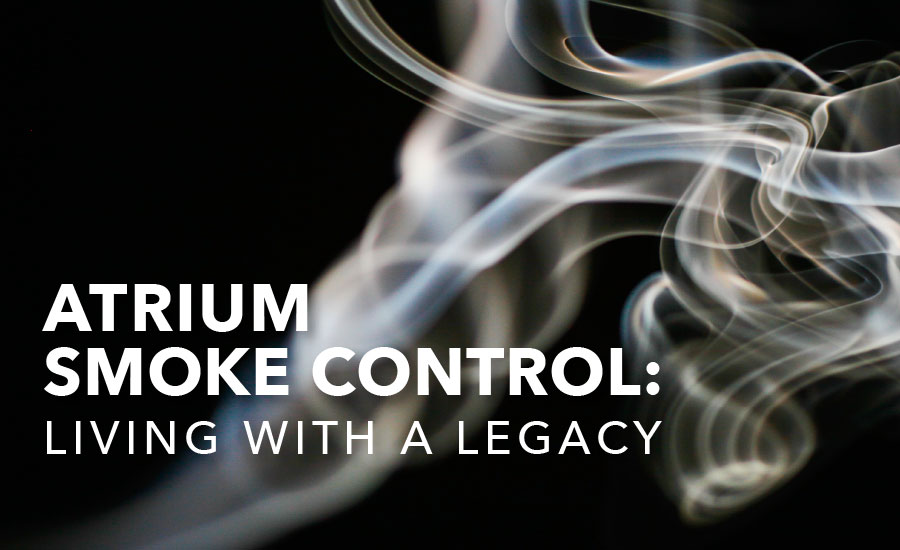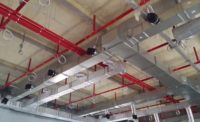Atrium smoke control systems built during the 1980s and ’90s are commonly found in buildings at colleges and universities throughout the United States. These legacy systems were designed prior to the development of performance-based codes and are based on simplistic approaches that do not include many of today’s best smoke control practices. Proactive colleges and universities are concerned about the adequacy of these aging smoke control systems to protect their students in a fire event. In these cases, educational institutions want to know if their smoke control system would meet today’s current codes or at least provide the same level of safety — and if not, what system improvements or changes would be needed to meet today’s standards?
Evaluating legacy systems under today’s current codes often presents the challenge of documentation gaps. Basic questions needed to properly evaluate a system may be unknown, such as the code of record, the system’s performance objectives, design assumptions, maintenance/testing history, sequence of operations, exhaust/make-up air fan capacities, and the location of one-hr fire rated separation.
LEGACY BUILDING CODES
Atrium smoke control systems built during the 1980s and ’90s are commonly based on legacy codes, such as the Building Official Code Administrators International (BOCA) code, Uniform Commercial Code (UCC), and the Standard Construction Code. These earlier legacy codes were based on a requirement of providing four to six air changes per hour and were therefore based solely on the volume of the atrium space. As knowledge of smoke control systems became more advanced, legacy codes evolved in the early 1990s to the requirement of maintaining a smoke layer 6 ft above the highest occupied level, accounting for the height of the atrium and expected fire size (irrespective of atrium volume).
Today’s smoke control systems are commonly based on a performance-based tenability analysis, using advanced fire modeling software packages such as those employing CFD. Fire Dynamics Simulator (FDS), developed by the National Institute of Technology (NIST), is a well-recognized CFD model used today for atrium smoke control design. Fire modeling is used in conjunction with a timed egress analysis (hand calculation or egress model). The fire modeling analysis is used to predict the Available Safe Egress Time (ASET), or the time in which the atrium space becomes untenable. This time is then compared with the predicted Required Safe Egress Time (RSET) as determined by the timed-egress analysis.
A performance-based analysis of this type considers many more factors than those required by the legacy codes, including the properties of smoke (i.e. temperature, visibility, and CO concentrations), exhaust and make-up air inlet locations and airflow velocities, location of occupants during egress, and features of the atrium geometry such as the ceiling space and available smoke reservoir.
SYSTEM EVALUATION STEPS
The following steps are recommended when evaluating a legacy atrium smoke control system:
-
Collect available documentation. What information is currently available for the building? If available, collect architectural and mechanical building drawings, fire alarm and sprinkler information, smoke control system information including performance objectives and sequence of operations. When was the last time the system was tested? Be prepared for building owners to say “we don’t know” or “we don’t have that information.”
-
Perform site survey and witness system activation. When evaluating a legacy smoke control system, it is imperative to perform a site survey to fill in the data gaps identified in Step 1. During the site survey, it’s very important to witness activation of the smoke control system in both automatic and manual modes. Based on testing dozens of legacy smoke control systems across the United States, it is fairly common when first activating a legacy system for that system to not perform its sequence of operation properly or to not turn on altogether. The problem is that many of these legacy systems sit dormant for years and are not periodically exercised, reducing the overall reliability of the system.
-
Perform testing and air balancing. It is vital to use the most accurate and up-to-date exhaust and make-up air fan capacities when evaluating a smoke control system. Due to the age of the system being evaluated, actual airflow capacities provided are questionable at best. There are a number of reasons why a fan may provide less airflow than specified on the fan’s identification plate or mechanical drawings. These factors include improperly designed ductwork, increased duct leakage, increased friction in fan bearings, malfunctioning dampers, and architectural changes to the building. Of these, the most common and significant factor is a malfunctioning damper. To improve the reliability of these dampers, more recent building codes, such as the International Building Code (IBC), require position switches on each system damper to confirm both the open and closed position of the damper.
-
Perform CFD computer modeling and timed-egress analysis. Using the data collected in Steps 1-3, perform a tenability-based analysis using CFD modeling and timed egress analysis. The goal of the analysis is to determine if the existing system would maintain tenable conditions during the calculated egress period. If the analysis shows the existing system is insufficient, provide recommendations for improvements.
COMMON SYSTEM UPGRADES AND RECOMMENDATIONS
If the analysis in Step 4 shows that the existing system is insufficient, there are a number of system upgrades that could increase the level of safety provided by the system. These recommendations may include:
-
Increased exhaust/make-up air capacities (determined by CFD modeling)
-
Passive separation on the upper levels of the atrium (such as operable fire/smoke doors or curtains)
-
Added smoke detection (such as beam detectors)
-
Improved notification system (such as a live, directive voice)
-
Additional exit signage (such as continuous floor lighting)
-
EFSR sprinklers
-
Devices for confirmation of airflow and damper positions
-
The addition of a graphical firefighter’s smoke control panel.
As previously mentioned, today’s IBC code includes provisions to improve the reliability of the smoke control system over its expected life span, including a graphical smoke control panel capable of performing preprogrammed self-tests. Requirements for the firefighter’s smoke control panel include, but are not limited to, manual controls, verification, and status lights for each fan and damper. Verification shall include positive confirmation of actuation and airflow, testing, manual override, the presence of power downstream of all disconnects, damper position switches and, through a preprogrammed weekly test sequence, report abnormal conditions audibly, visually, and by printed report (i.e., UULK-listed panel).
The legacy codes did not include these provisions to improve system reliability. The costs associated to upgrade a legacy system to include these provisions may be prohibitive. In these cases, at a minimum, it is recommended to have the system tested manually on a monthly basis to improve the reliability of the system. Periodic testing of all equipment associated with the smoke control system (such as initiating devices, fans, dampers, controls, and doors) should be performed. The main purpose of this monthly test is to confirm the system’s sequence of operations and to exercise the fans and dampers so they do not sit for long periods of time.




